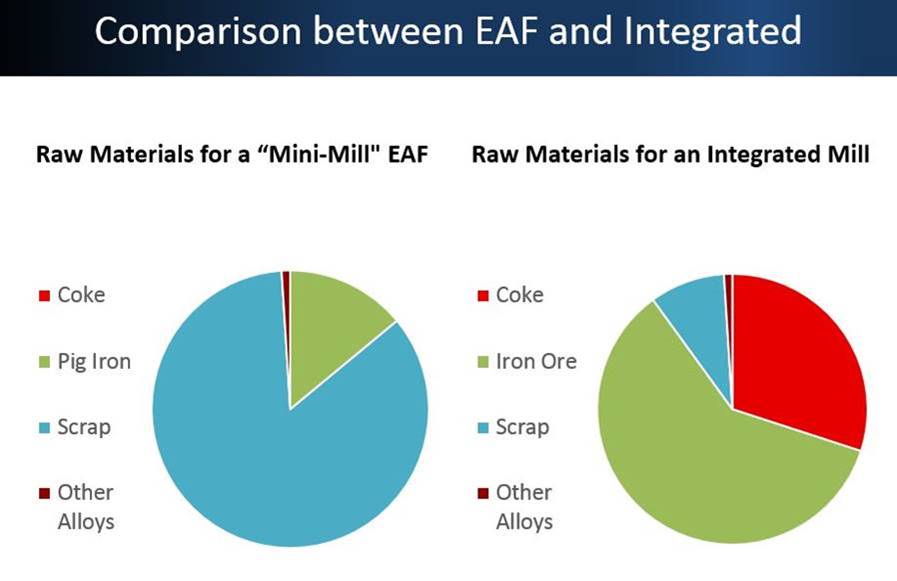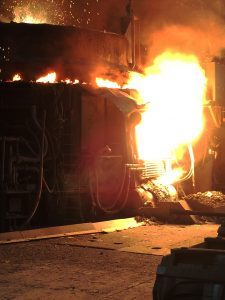Steelmaking 101
With all that is happening in today’s steel market, I think it would be helpful to review the two primary ways to make steel.
There are two ways to make steel—in a Blast Furnace (BOF) or in an Electric Arc Furnace (EAF). In the U.S., approximately 75% of steel is made using the EAF method, and 25% is made by integrated mills using a basic oxygen furnace (BOF). Worldwide, however, that ratio is reversed with only about 35% of the steel made using EAF technology.
Those mills that make steel using a BOF – like AK Steel and U.S. Steel – are commonly called integrated mills. Those mills that make steel using an EAF – like Nucor and SDI – are referred to as mini mills.
Here are the differences:
Integrated mills make steel from scratch. They melt iron ore in a Blast Furnace to produce liquid iron. The blast furnace is a huge steel stack lined with refractory brick, where iron ore, coke, and limestone are dumped into the top. Preheated air is blown into the bottom. After many hours, it produces liquid slag and liquid iron.They remove the slag and combine the liquid iron with scrap metal in a Basic Oxygen Furnace (BOF), where pure oxygen (>99.5% pure) is blown in at supersonic velocities. It oxidizes the carbon and silicon contained in the hot metal, liberating great quantities of heat, which melts the scrap. It then gets refined and poured into a slab that will eventually be reduced down to a coil.
Mini mills make steel predominantly from scrap. The EAF process uses steel scrap and pig iron, melting them using electricity to make new steel. The process is much quicker and much easier to start up and shut down. It also far fewer steelworkers. This liquid steel also get refined and poured into a slab.
Click here for a great visual showing the two methods.

In contrast to the situation in the United States, the leading global producers of steel (Brazil, South Korea, Japan, Russia, Germany, and especially China) primarily rely on basic oxygen furnace capacity rather than electric arc furnace capacity (see Figure). According to the DOC, “each of these economic competitors to the United States possess critical research, development and production capabilities that the United States is in danger of losing if imports continue to force U.S. steel producers to operate at uneconomic capacity utilization levels. A further reduction in domestic basic oxygen furnace capacity would put the United States at serious risk of becoming dependent on foreign steel to support its critical industries and defense needs. Allowing this decline to continue represents a ‘weakening of our internal economy that may impair national security’ which the Congress has directed the Secretary to advise the President of under the Section 232.”
- Basic Oxygen Furnace (BOF) Steelmaking – This process converts pig iron from the blast furnace into liquid steel by blowing oxygen into the furnace to remove carbon as carbon monoxide gas.
- Electric Arc Furnace (EAF) Steelmaking. In this process an electric furnace melts (recycles) steel scrap for the production of liquid steel using electrical power.
In BOF steelmaking, the main raw material inputs are iron ore and coal. In EAF steelmaking, the main raw material is ferrous scrap. Currently, scrap represents around 75% of EAF input.
At a very elementary level, steel is made using red rock, black rock, and white rock. These are iron, coal, limestone, and other alloys.
All flat rolled steel starts out as a hot roll band that weighs approximately 20 tons (40,000#). One ton (2,000 pounds) of hot roll band requires 1,400 pounds of coal, 2,700 pounds of iron ore, plus scrap metal, limestone, and other alloys. The coal is converted to coking coal. In a separate process the iron ore is converted to iron ore pellets. These two ingredients are combined and heated in a gigantic blast furnace until it becomes liquid steel, also known as molten pig iron. This is then transferred to an oxygen furnace where scrap, limestone, and other alloys are added to purify the steel. It is then transferred to a hot rolling mill where it is reduced from a slab of steel into a thinner hot roll band. All cold rolled steel, and thus all Galvanized steel, starts out as an HR band!

